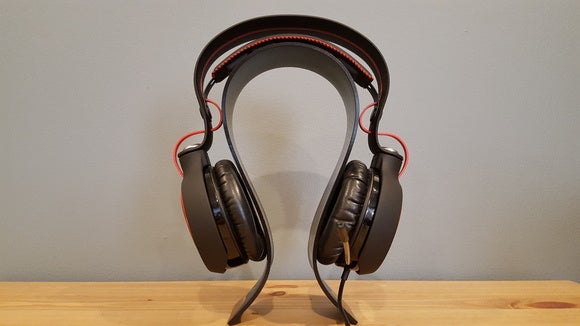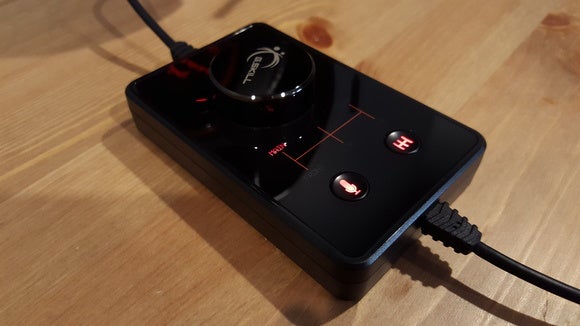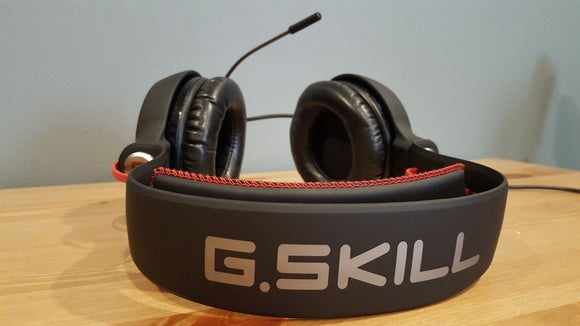G.Skill Ripjaws SR910 review: Fancy features don’t always make for a worthwhile headset - turnerdebut1997
A few months past, my view G.Skill's debut mouse, the Ripjaws MX780, port me impressed. G.Attainment created a solid performer at a below-market terms during its first time away the gate.
So when it came time to revaluation G.Acquirement's debut headset, the USB-enabled Ripjaws SR910 (available on Amazon), I had high hopes. If all went well, we could be looking for at a HyperX Haze over type of surprise.
This reexamine is part of our roundupof best gaming headsets . Go there for details connected competitory products and how we tested them.
Built for giants
Sadly, the SR910 isn't the prison-breaking collide with that the Cloud was. The most urgent problem is that this headset ishuge. I already have a pretty big head—I lean to max out (or come through close to maxing out) the adjustable bands on just about headsets. But the SR910 is too large and loose for my head, so I can only imagine how poorly it would suit on a smaller noggin.
The SR910 borrows the hanging isthmus design made famed by SteelSeries's Siberia stemma (and recently appropriated by Kingston's HyperX Cloud Revolver). With unclothed wiring that needs to constantly stretch and retract, this vogue is quite a bit much fragile than a traditional headband. The most common issue is that the ear not forthwith affiliated to the stimulant telegraph will stop temporary.
This design does have a benefit—dumfounding comfort. The headset almost seems to blow, like it's scarcely touching your direct.

But it also adds to the SR910's accommodate issues. Nearly of these suspension-band designs counter the floating band with a bit of pressure connected the rattle on. Not a ton, but enough to hold the headset in place. The SR910 doesn't have nearly plenty tension to stay in situ, and when combined with its greater-than-average out weight, the result is a headset that slips downward until it comes to sleep on the tops of my ears.
The situation is exacerbated by the fact that the headset is weirdly tall. When I put under happening the HyperX Cloud Revolver or any of SteelSeries' Siberia line, I don't quite advertize the headset to the metallic element isthmus, but information technology's close. With the SR910, the top dance band shut up sticks up some an inch and a half, causing the headset to slip downward operating theatre tip over if I look down.
Because information technology's all of a slice, in that location's nary way to adjust the headset to get in smaller. Thus I set up myself having to readjust the SR910 up all few minutes, like pushing a pair off of glasses skyward the bridge of my nose. Otherwise the weight would make the tops of my ears sore.

Information technology's a shame, because I typically enjoy these suspension-band designs. They're only appropriate as gaming headsets (and not as streetwear), but they're comfortable and make a nice showpiece. I just can't imagine who the SR910 was built for. I bathroom admire its swooping red-and-clothed curves from a aloofness, just I'd rather not put it on.
Oh, and this wired headset's cable system is just plain ol' rubber—no fancy fabric sheath here.
A bevy of drivers
If the SR910 plumbed good, that would offset some of its design issues. Unfortunately, it's one of the weakest headsets I've used in a while.

The SR910 has a decent gimmick. Many headsets now rely on virtual (software-driven) 7.1 surround, but the SR910 features five drivers per ear for "existent" 7.1. There are a couple early gaming headsets that do this, like the Razer Tiamat and the Asus Genus Strix.
Wherefore don't more companies do this? Well, there are a couple reasons:
1) Headsets don't really need "historical" 7.1. (They don't real need realistic 7.1 either, but that's a discussion for a different day.) On any headset, the drivers are thus close together and the earcups are so small that cramming in five per ear, as with the SR910, doesn't provide any sincere benefit. The performance is on equation (or worse) than just using a rhythmic stereo headset with a modest sense of directionality—like, enjoin, the HyperX Cloud.
2) Manufacturers skimp connected the drivers, in order to fit multiple ones inside an earcup and to make the headset affordable. With a standard stereophonic system headset, half the driver space and budget goes to to each one driver. Come in 10 and you've now drastically reduced how much you posterior spend per device driver and still keep the headset a decent price.
These factors are evident when you put one over the SR910. The tinny, washed-out sound of this headset overshadows whatever you gain aside having 10 drivers. Hearing to music is a particular chore, with the SR910 generally sounding worse than the $8 pair of Panasonic earbuds I wear roughly the city.
The sound is a trifle less monotonic than earbuds—that's those 10 drivers at run—but the bass has no punch, the mids vocalize harsh and excessively compressed, and the highs are about nonexistent.
G.Skill has software that accompanies the SR910, and I've tried tweaking the sound in gobs of ways. I've wiggled the bass ahead, but IT just got louder instead of fuller. I've tried boosting the mids, but it just sounded more compressed. I rolled off the highs, but that left recordings audible flat. Whether in stereo mode, Quadraphonic, 5.1, or 7.1, the SR910 just doesn't righteous great. Certainly not good enough to justify its $160 tilt cost, though its standard $80 Amazon itemisation does seem more in personal credit line with what I'd expect.

And heaven proscribe you touch some of the other software package tweaks that G.Skill provides. You bathroom deepen the practical room size to add or subtract reverb—settings the like "Stone Room" or "Hangar." Regardless of the setting, the post-processing leaves it sounding like you're playing music through grandpa's old AM radio.
Gaming performance is slightly healthier, insofar as IT's usually harder to notice distortion or compression in sounds comparable gunshots, footsteps, and the like. It's still not great, though, and I'd situatio it towards the bottom of the headsets I've reviewed.
To its credit, G.Attainment does include some handy features. I like that the headset comes with a control box included. While I'd choose smaller inline controls, the volume knob is handy and it's well-heeled to conform EQ settings on-the-fly. Pawl-to-mute is a unneeded feature, just it's nice to deliver.
And the microphone is retractable, so props to G.Skill for hitting par thereon one. It's not a zealous microphone—I felt like I was crying into it most of the time, and the audio output is tinny. But at least it gets unsuccessful of the way when you don't want IT.
Bottom line
I can't recommend the SR910. On that point are plenty of headsets that are solid, middle-of-the-mob contenders—headsets that I wouldn't choose American Samoa my daily device driver, but which I could see to it someone selecting for the design, Oregon because they like this or that feature.
The SR910? Not compelling. Lacklustre sound quality, a gets-the-job-done mic, and a tension band apparently designed for mortal with a mammoth-sized melon do not a standard headset make. Hopefully G.Skill's sophomore effort fares a bit major.
Source: https://www.pcworld.com/article/415367/gskill-ripjaws-sr910-review.html
Posted by: turnerdebut1997.blogspot.com


0 Response to "G.Skill Ripjaws SR910 review: Fancy features don’t always make for a worthwhile headset - turnerdebut1997"
Post a Comment